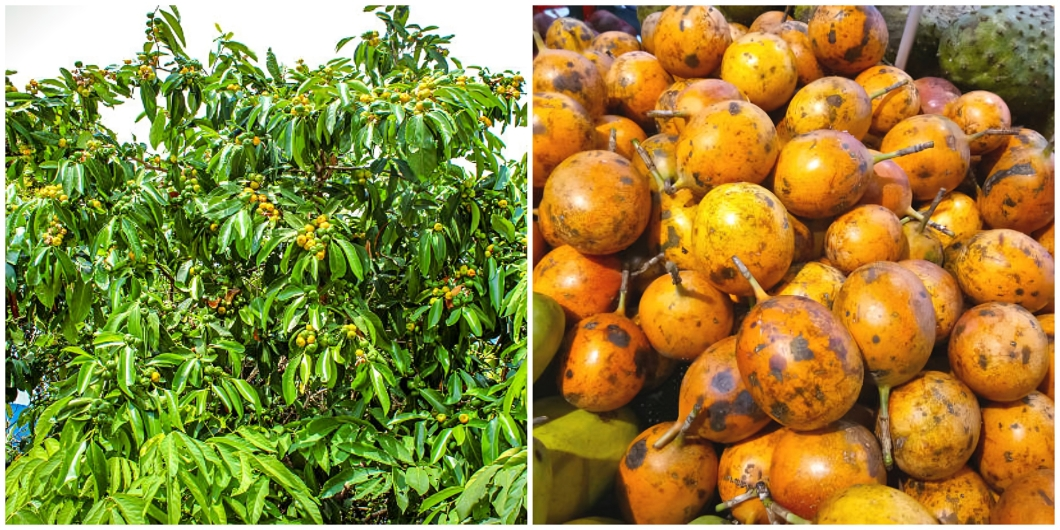In many Nigerian households, the sweet-and-sour taste of udara is a familiar delight. Known in English as the African star apple (Chrysophyllum albidum) and as Agbalumo among the Yoruba, the fruit is no stranger and is always a favourite during its seasonal arrival. But beyond the burst of that tangy juice lies a deeper story, one that is rooted in spirituality, mystery, and reverence.
Among the Igbo people, the udara tree is more than just a fruit bearer. It is a sacred female deity tree with a centuries-long tradition as a symbol of fertility, protection, and ancestral connection.
A Sacred Symbol of Fertility and Protection
In Igbo cosmology, trees are not merely plants; they are living symbols of the unseen world. Therefore, the udara tree holds a unique place and is often regarded as a fertility deity tree. It is believed to ward off barrenness and bless women with children.
There are folklores of families who planted udara trees near their compounds as a spiritual safeguard just to ensure both the fertility of women and the protection of their household.
This association with womanhood also ties the udara tree to Ala, the Earth goddess and guardian of morality and fertility in Igbo belief. Just as the earth nurtures life, the udara tree is seen as a maternal force that nurtures both the living and the yet-to-be-born.
In some communities, the tree is said to house the spirits of ancestors and unborn children, making it a sacred link between generations.
Beyond fertility, the udara tree has also been regarded as a witness tree. In Igbo traditional beliefs, oaths taken beneath it carried spiritual weight and were considered binding.
In disputes, invoking the udara tree’s spirit was almost the same as calling on the ancestors themselves. Its enduring presence in the village square or at shrines made it a silent guardian of truth and justice.
Why You Dare Not Pluck Fruit from Udara Tree or Cut it Down
What makes the udara tree truly stand out is not only its sacred symbolism but also the taboos that surround it. For centuries, in most parts of Igboland, it has been forbidden to pluck its fruits directly from the branches. To do so was considered an act of disrespect, which is more or less an attempt to “force” the hand of the deity.
Instead, people were expected to eat only the fruits that fell naturally to the ground. This is said to be a reminder that fertility, like fruitfulness, comes in its own time and cannot be rushed.
“Cutting down the udara tree is like a taboo. In fact, doing so, one was believed to bring grave misfortune upon their family or even the community at large. The tree is believed to be under spiritual guardianship, and disrespecting it could invite the wrath of unseen forces,” a senior citizen, Mr. John Anyanwu, noted.
Other than cutting the tree, it is also forbidden to defecate beneath the udara tree, a practice seen as an insult to the spirits dwelling there. Such prohibitions strengthen the tree’s sacred status, ensuring its preservation across generations.
Healing in the Bark and Leaves
The udara tree’s significance is not purely spiritual. Traditional medicine draws heavily on its properties. A research study by the Department of Biological Sciences, College of Science and Technology, Covenant University, Ogun State, Nigeria, showed that the African cherry can be used in treating various diseases, including fever, diarrhea, coughs, stomachaches, constipation, and other minor illnesses.
The fruits themselves, rich in Vitamin C and antioxidants, are believed to support the immune system and boost overall health. In many rural areas, healers continue to prepare remedies from udara parts, blending spiritual reverence with practical healthcare.
Pan African Context
While the udara tree’s most vivid sacred traditions are found in Igboland, its cultural value extends across other parts of Africa, especially West Africa. In the Benin Republic, for example, the tree is referred to as Azáza. It is often preserved in agroforestry systems, that is, a farming practice where trees are deliberately left standing alongside crops.
Farmers rarely cut down the trees because they regard them as too valuable to lose. Beyond their fruits, which provide both nourishment and income during the dry season, the trees enrich the soil with their fallen leaves. Their wide branches offer shade for smaller plants and serve as a ready source of herbal remedies.
In Ghana, where it is known as Alasa, it is prized for its nutritional and medicinal qualities, although it is less entwined with strict spiritual taboos. Across other ethnic groups in Nigeria and West Africa, the fruit is highly valued, and the tree is widely used in folk medicine for treating fever, malaria, infections, and digestive disorders.
While the spiritual significance of the udara tree is strongest among the Igbo, similar threads of reverence are also found across Africa. Many cultures share the belief that the tree should not be cut down casually, as it carries protective or ancestral significance.
The udara tree is not just a fruit tree. It is a sacred entity, a female deity tree of fertility and protection, bound by taboos that emphasise reverence and respect. Whether or not you believe in its mystical powers, the stories surrounding the udara tree showcase a culture that honours both the seen and unseen, the physical and the spiritual.
>

